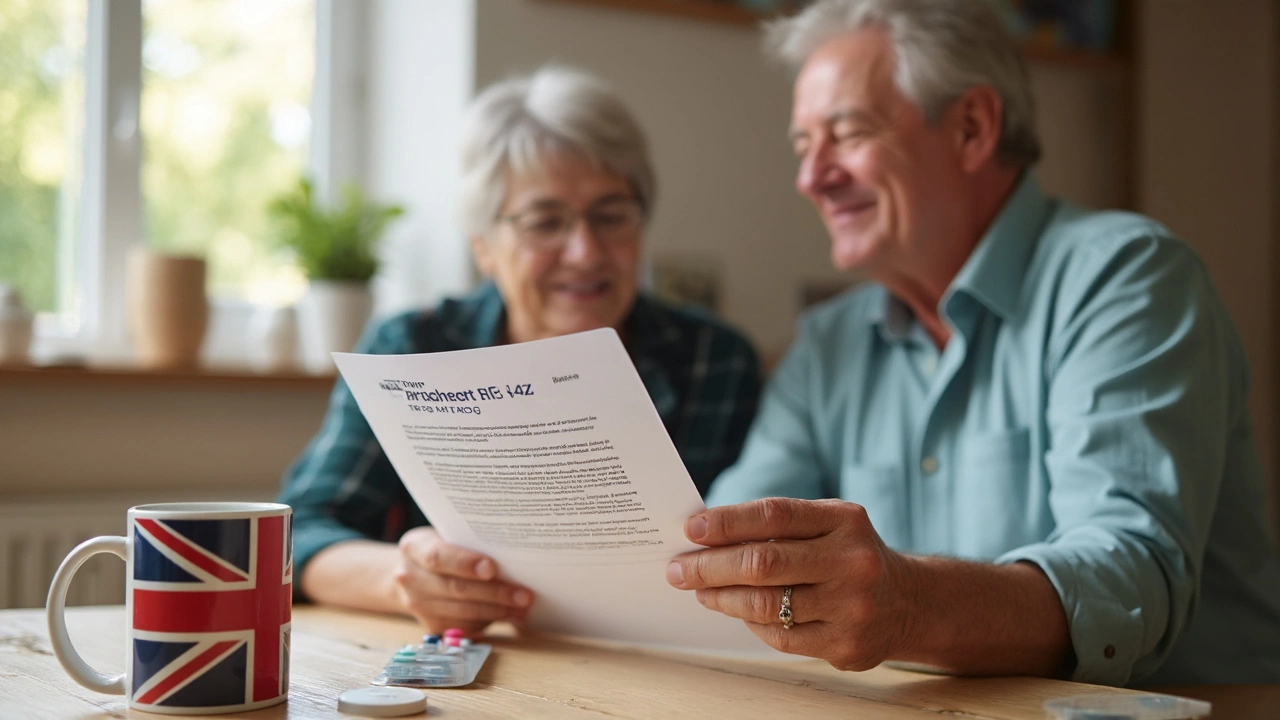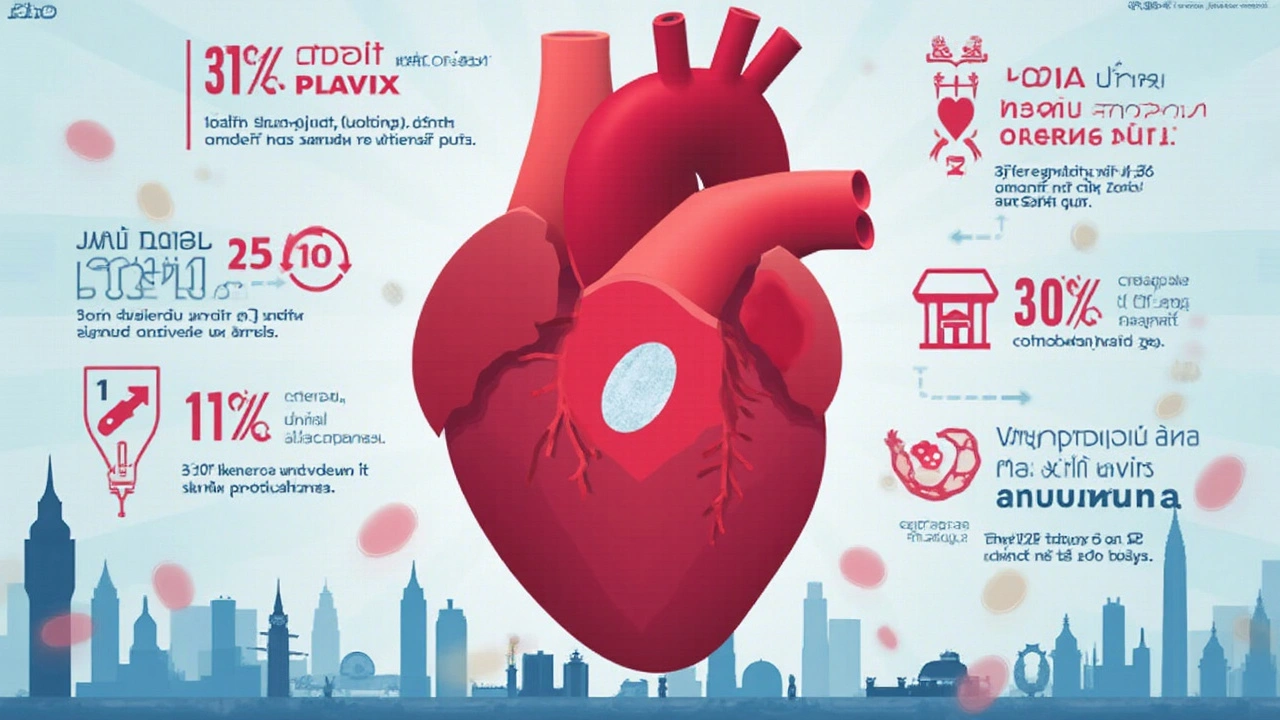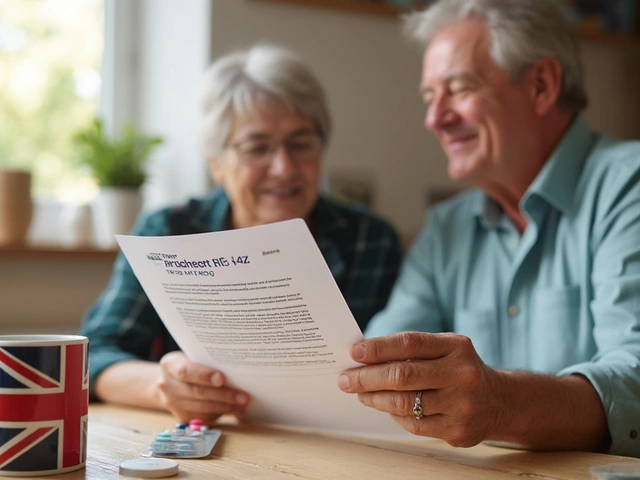
Your doctor hands you a prescription and says, "Don’t forget to pick up your Plavix." You nod, smiling like you understand, but really, your brain’s buzzing with questions. Is this drug going to change your life? Is it dangerous? Can you play rough outside with your kids, or is every scrape going to be a disaster? So many people hear the word "blood thinner" and think of horror stories, but most aren’t getting the full picture. Plavix isn’t some exotic magic pill—it's a powerful tool that could literally save your life, or protect someone you love.
How Plavix Works in Your Body
Plavix, with the generic name clopidogrel, belongs to a class of drugs called antiplatelets. That might sound technical, but it basically means it keeps blood cells (called platelets) from sticking together and making dangerous clots. Why does that matter? Because clots are the sneaky troublemakers behind heart attacks and strokes. Lots of us—especially anyone after age 50—face higher risks for those, whether, like me, you’ve got a family history, enjoy the occasional cheeseburger, or deal with high cholesterol. Plavix helps by making it harder for platelets to clump up and block blood flow in your arteries—think of it as helping your blood run a little smoother, like oil in an engine.
The science isn’t just guesswork. In a huge trial called the CAPRIE study, folks with recent heart attacks, strokes, or peripheral arterial disease (problems with blood vessels in their legs) took Plavix. Researchers found it outperformed aspirin at cutting their risk of heart problems and repeat strokes, dropping the combined risk by about 8.7% compared to aspirin.
“Clopidogrel is the cornerstone therapy for people who have had a stent placed after a heart attack. It gives us a way to keep arteries open and prevent new clots that can be deadly,” says Dr. Deepak Bhatt, Harvard Medical School cardiologist.There’s more—if you’ve got a stent in your heart, your doctor will almost always put you on Plavix, sometimes with aspirin, to stop your body from closing up that lifesaving pipeline with a clot.
So, what does that mean for you? It means that if you’ve been prescribed Plavix, your doctor figures your risk of a blood clot doing damage is higher than your risk of bleeding. It’s not a lightweight decision, and nobody gets it just "for fun." If you see the name "clopidogrel bisulfate" on your pills, that’s the same thing as Plavix. It kicks in within two hours, and you’ll typically take one tablet every day, around the same time—easy enough to remember alongside your morning coffee, but if you aren’t a morning person (I get it), pick a time you won’t forget.
Who Needs Plavix—and Who Doesn’t?
The big question everyone has is: Do you really need to take this blood thinner? Not everyone does, honestly. Plavix is mostly for people who’ve already had a heart attack or stroke, or those who just got a stent in their heart. Sometimes, doctors prescribe it if you have a disease called "peripheral arterial disease"—which basically means your leg blood vessels are clogged, and walking even a few blocks hurts like hell. Other folks, especially those with specific risk factors (high blood pressure, diabetes, smokers, or strong family history) are also likely candidates.
This isn’t a "one size fits all" kind of drug. Taking Plavix when you don’t need it—say, just because you heard it was good for arteries—can actually be risky. Since it makes blood less likely to clot, you could bleed more easily after a cut or surgery. There’s a balance: your doctor weighs the danger of a clot (heart attack or stroke) against the danger of bleeding too much. If you’re healthy, under 40, with almost zero risk factors and no heart procedures, Plavix probably isn’t for you.
Sometimes, there are other reasons NOT to take Plavix. If you’ve ever had an allergic reaction to clopidogrel, obviously, steer clear. If you’ve got active bleeding—think ulcers, recent brain bleeds, or severe liver disease—the risks quickly outweigh the benefits. That gets even trickier if you’re taking other medications that interfere with blood clotting, especially strong ones like warfarin (Coumadin), which is a different type of blood thinner. Your healthcare provider will check all your meds to make sure there’s no dangerous overlap.
Here’s something a lot of patients overlook: genetics can change how well Plavix works. About 30% of people (that’s one out of three, which is no small number) have genetic quirks that make them “slow metabolizers”—their bodies don’t activate Plavix as well. There’s a test for this, but it’s not always routine. If you’re worried, or if you have a family member who had a blood clot on Plavix, bring it up with your doctor. Some hospitals in Minneapolis even offer this test as part of their heart clinics now.
| Who Typically Gets Plavix? | Who Should Skip Plavix? |
|---|---|
| Recent heart attack survivors | Known allergy to clopidogrel |
| Stroke survivors | Active bleeding (ulcer, GI bleed, brain bleed) |
| People with stents | Severe liver disease |
| Peripheral arterial disease patients | Taking certain other anticoagulants (unless specifically approved) |

Side Effects: What to Watch For
Let’s be real—the word “blood thinner” is enough to make anyone feel nervous. Bleeding worries are the main thing, and you should be aware of possible side effects, but also how rarely some of the worst actually happen. Nosebleeds, bruising more easily (I find this whenever my kid Radley wallops me with a foam sword and I end up with a black-and-blue arm), or gum bleeding when you brush your teeth are all possibilities. But for most people, these are more annoying than dangerous. A Minnesota cardiologist (the same one who helped my dad through his heart issues) always told us, “If the bleeding can be seen and stopped, it’s rarely urgent. If you can’t see it, or can’t stop it, get help fast.”
Rare but serious issues: Big internal bleeds, especially in the brain (stroke), stomach or intestines, are possible—but these happen in less than 1% of people on Plavix. The risk rises if you’re older, have a history of ulcers, or are taking Plavix together with aspirin or NSAIDs (like ibuprofen). Another rare but real side effect is a weird one called "thrombotic thrombocytopenic purpura" (TTP)—which is doctor-speak for your body’s platelets dropping super low and weird bruising showing up, often with fever and confusion. This is an emergency, but it probably happens once in 100,000 prescriptions or less.
Some folks also have allergic reactions (rash, swelling, trouble breathing). That’s your cue to stop Plavix and get to the ER ASAP. I’ve seen this once, in a neighbor who suddenly swelled up like a balloon—and he was fine after a hospital visit and a switch to another drug.
The big question for parents: Can you play with your kids, roughhouse, or garden without living in fear? Most doctors will say yes if you use your "common sense." Watch for more bruises, skip really sharp tools, and wear gloves or sleeves if you’re trimming thorns. Don’t avoid normal life—you’re on Plavix so you can enjoy more days doing what you love, not hiding from every bump or scratch.
- Let your dentist and all your doctors know you’re on Plavix before any procedures.
- If you get a minor cut that won’t stop bleeding after 10-15 minutes, seek prompt help.
- Keep a list of your meds handy in your wallet or on your phone.
- Skip over-the-counter herbal supplements like ginkgo, garlic, and turmeric, which can also thin blood.
Everyday Tips for Living with Plavix
Taking Plavix doesn’t mean wrapping yourself in bubble wrap. I still go biking with Radley and pull weeds out back. But you learn a few tricks to make life smoother. If you’re someone who loves sharp kitchen knives or woodworking, swap for safer, rounded tools — less chance of an “oops” moment. Ditch the straight razor—go electric on your face. A little planning protects you from big headaches later.
Some foods can interact, but not as many as other blood thinners. You don’t need to overhaul your diet, just watch your alcohol: heavy drinking can make bleeding more likely. Go easy if you love a good IPA or red wine. Your platelet count won’t drop just from a salad or some fish, so no need to stress about that.
One of the most important things: never just stop Plavix on your own, especially if you’ve had a stent. Stopping suddenly is risky business—the clot could form in days and shut down your new artery, with tragic results. “The highest risk for a stent clot is within the first month of stopping antiplatelet therapy,” says Dr. Roxana Mehran, a world-leading cardiologist. So, always check with your provider. Sometimes, before a surgery or dental procedure, your doctor might tell you to pause—but only after careful planning. They know when and how to do this safely.
Don’t forget to check expiration dates. Old pills lose potency, and you don’t want to be flying blind thinking you’re protected when you’re not. Keep your meds in the original bottle, away from heat and light, and out of reach from curious little hands.
If you forget a dose? Take it as soon as you remember—unless it’s almost time for the next one. Don’t double up (double the bleeding, zero the benefit). Set a phone alarm, or link it to a daily routine like brushing your teeth. My trick is putting the pill bottle by the coffee pot. Works every morning.

Important Facts, Studies, and What the Future Holds
Plavix is one of the most-studied medications of the last thirty years, with over 100 million prescriptions written globally. The original FDA approval was in 1997, and it’s stayed relevant because it just plain works—or as Dr. Braunwald, famed heart researcher, says, “Clopidogrel has reshaped the landscape of heart attack care.” Its patent ran out in 2012, so now loads of affordable generics are available, making it way cheaper for most people. No gold-plated pharmaceutical pricing here.
There’s still a lot of research happening in 2025. Scientists are working on “next-gen” antiplatelet drugs, but nothing has yet replaced Plavix’s track record for people with stents and repeat clot risks. Some new medicines switch on or off faster, but with more cost and sometimes more side effects. Studies in the last few years from the American College of Cardiology showed Plavix is still a best guess for most moderate-risk patients—especially those who don’t tolerate aspirin well. About 10% of people do have that genetic difference we talked about, that blunts the drug’s effect; there’s talk of routine gene testing coming in the next few years so everyone gets fully personalized blood thinner choices.
Here are some stats that may surprise you:
| Fact | Number |
|---|---|
| Number of annual U.S. Plavix prescriptions | Nearly 20 million |
| Average risk reduction for secondary heart attack or stroke | 22% |
| Chance of major bleeding on Plavix | Less than 1% per year |
| Percent of people with gene variation lowering effect | About 30% |
So where’s this all going? Maybe in a decade, there will be drugs tailored to your DNA, side effects barely a blip, and treating heart disease will be as simple as treating a sore throat. But right now, Plavix is still the real workhorse in preventing clots and saving lives, especially for anyone at high risk for heart attack or stroke. If you have questions about your prescription, ask—don’t just Google, and don’t trust rumors from the neighbor who swears apple cider vinegar is just as good. Your blood deserves the real facts, and so do you.



Man, I was so scared when I got my first Plavix script after my stent. Thought I’d never hug my grandkids again without worrying they’d crack my ribs. But turns out? I’m biking, gardening, even wrestling with my 8-year-old now. Just don’t go swinging axes or climbing ladders barefoot. Common sense beats fear any day.
Plavix ain’t magic, but it’s the closest thing we got to a bodyguard for your arteries.
Let’s be real - this whole ‘blood thinner’ thing is Big Pharma’s way of keeping you hooked. Ever wonder why they don’t push natural stuff like turmeric or garlic? Because they can’t patent it. And don’t get me started on that ‘30% genetic flaw’ line - that’s just them covering their asses when the drug doesn’t work for you.
My cousin took it for six months and got a GI bleed. They called it ‘rare.’ I call it ‘predictable.’
I just wanted to say thank you for writing this so clearly 😊 I’ve been on Plavix since my dad’s bypass and honestly? I used to panic every time I scraped my knee. Now I just keep a first aid kit by the door and keep moving. You’re right - it’s not about living in a bubble, it’s about living smarter.
Also, coffee + pill every morning is my new ritual. It’s weirdly comforting 💛
Plavix? More like Plavix-lies. Everyone’s scared of clots but no one talks about how many people bleed out from this stuff. And why’s it always ‘take it daily’? Why not just take it when you feel like you’re gonna have a heart attack? Seems dumb to me.
Also, my dog’s on aspirin and he’s fine. Why can’t I just give my dog’s pills to myself?
Okay, let’s cut the fluff. Plavix works. It’s not perfect, but neither is your grandma’s casserole dish. You got a stent? You’re on it. No debate.
Genetic testing? Yeah, it’s a thing. But unless you’re in a fancy clinic in Minneapolis, you’re probably not getting it - and you don’t need it. Most people respond fine. Stop overthinking it.
And no, turmeric won’t replace it. That’s not medicine, that’s a Pinterest post with a lemon wedge.
Also - don’t stop it. Ever. Not even for a tooth extraction. Talk to your doc. That’s the only rule that matters.
In India, we call this medicine 'blood cleaner' - not thinner. It feels more accurate. My uncle took it after his angioplasty. He didn’t stop walking to the temple, didn’t stop cooking. He just stopped using sharp knives and started using rubber gloves.
Medicine is not fear. It’s responsibility. And responsibility means knowing your limits, not avoiding life.
Also - never trust a neighbor’s advice over a doctor’s. We’ve seen too many people die from 'natural cures' and 'herbal alternatives.'
It’s alarming how casually people treat anticoagulants like over-the-counter painkillers. Plavix is not a vitamin. It is a pharmacological intervention with documented, life-altering risks. The fact that your post normalizes it with anecdotes about foam swords and coffee routines is dangerously reductive.
There are 17,000 documented cases per year of intracranial hemorrhage linked to antiplatelet therapy. You mention ‘less than 1%’ - but you don’t mention that 1% is still 10,000 people. That’s not a statistic. That’s your neighbor. That’s your cousin. That’s your mother.
Respect the drug. Respect the science. Stop romanticizing it with gardening metaphors.
I love how this post didn’t just dump facts - it gave us permission to live. I used to feel like I was carrying a ticking bomb inside me after my heart attack. Then I read this and thought - hey, maybe I can still grill burgers with my boys without sweating bullets.
And yeah, I know the stats. I know the risks. But I also know that if I never play catch with my kid again because I’m scared of a bruise, I’m already dead.
Also - I just got my genetic test done. Turns out I’m one of the 30%. So my doc switched me to Effient. It’s pricier, but I feel better. So if you’ve been on Plavix and it’s not clicking? Talk to your doc. There are options.
And yes, I still put my pill bottle by the coffee pot. No shame in routines that save your life 🙌
Thank you for the thorough and balanced overview. While the tone is conversational, the information presented is clinically accurate and appropriately nuanced. I appreciate the emphasis on individualized risk assessment and the clear distinction between appropriate and inappropriate use cases.
It is also commendable that you highlighted the importance of medication adherence and the dangers of abrupt discontinuation, particularly in post-stent patients. This is a critical point often misunderstood by the lay public.
Further, the inclusion of practical, non-alarmist advice regarding daily activities promotes patient autonomy without compromising safety.
My dad’s on Plavix. He’s 72. He still fixes his own bike, chops wood, and argues with the mailman. But he also keeps a list of meds in his wallet, wears gloves when he gardens, and told his dentist he’s on it before he even got the drill out.
It’s not about being scared. It’s about being smart. And yeah - I got my blood tested for CYP2C19. Turned out I’m a slow metabolizer too. So I switched to ticagrelor. More expensive? Yeah. But I’d rather pay extra than die because I didn’t ask the right questions.
Don’t just take the pill. Ask: ‘Does this work for ME?’ That’s the real prescription.
Plavix saved my life. I had a stent at 48. Thought I was done. Turns out I’m not. I ride my bike 30 miles every weekend. I play with my grandkids. I don’t run with scissors, but I don’t live in a padded room either.
Here’s what no one tells you: the real enemy isn’t Plavix. It’s silence. People don’t ask questions. They just take the pill and hope. Don’t be that person.
Ask about genetics. Ask about alternatives. Ask about bleeding risks. Ask about your doctor’s own meds - they might be on it too. And if your doc rolls their eyes? Find a new one.
This drug isn’t a curse. It’s a tool. Use it right.
plavix is just aspirin with a fancy name and a higher price tag lmao